Just hours of presumed oxygen endurance remain for the passengers and crew of a submersible lost near the wreck of the Titanic, but more aircraft and ships are joining the last-minute hunt to save those onboard.
When the submersible Titan dived with two crew and three passengers on Sunday morning, it was only due to be underwater a matter of hours, but nevertheless was said to be carrying 96 hours of reserve oxygen onboard. If the loading is correct and the oxygen onboard is consumed at the presumed rate, that could give those onboard — assuming the craft is still in one piece and those onboard are still alive — until just 1130 BST (0630 ET) today.
Yet the conditions onboard the Titan are not known, how quick oxygen is being consumed is unknown and how well those onboard have been able to conserve what oxygen they have may vary, an academic has told UK state broadcaster the BBC this morning. Dr Ken LeDez of Memorial University in St John’s, Newfoundland said if those onboard huddled together to keep warm and refrained from physical activity — even avoiding shivering in the cold depths of the ocean by sharing body heat — that would mean less oxygen consumed.
‘Underwater Noises’ Detected in Hunt for Missing Titanic Submarine, But Time Running Outhttps://t.co/nWPYuylbwQ
— Breitbart London (@BreitbartLondon) June 21, 2023
Ultimately, Dr LeDez said, some onboard could survive a low oxygen state longer than others, calling the idea of some occupants having a chance of survival at the last minute but not others a “disturbing” conversation. The academic also spoke of the potential benefit of the cold onboard the submarine, saying the temperature on the ocean floor is around 0°C (32F).
Dr LeDez said, per the BBC: “There is a possibility if they cool down enough and lose consciousness they could live through it – rescuers know this”.
The discussion of oxygen levels onboard the submersible Titan is, however, based on a lot of assumptions, not least that when the craft lost contact with the surface on Sunday, it was not due to a catastrophic failure destroying the craft.
Meanwhile, the search continues. The U.S. Coastguard has published an image detailing the search grids deployed by air and surface assets to attempt to locate the sub. A large red cross appears to state the last known position of the Titan, above the wreck of the Titanic, and the grids overlaid show a strong bias towards searches to the southeast, underlining local weather and tidal conditions, showing which way rescuers think an unpowered craft would have drifted in the time given.
As time has gone on, more ships have joined the search. French survey vessel L’Atalante is one of the latest and its publicly-published GPS data shows it, at time of publication, proceeding at five knots over the wreck of the Titanic. The ship carries an advanced undersea “robot” (‘Remote Operated Vehicle’, of ROV) which can dive to the Titanic’s depth without being destroyed.
Remote-controlled Victor 6000 couldn’t bring up the stricken submersible under its own power were it discovered, reports NBC, but could attach a line to haul it up with.
Per the U.S. Coast Guard, eight ships have arrived or are on their way to assist, with at least four ROVs available to search, as well as aircraft. One of the craft inbound is the HMCS Glace Bay, a Canadian warship that departed Halifax on Tuesday and is carrying a “mobile decompression chamber” and medical personnel.
As interest in the missing submarine has gripped media worldwide, more attention has come to focus on how the submersible Titan came to be lost. As previously reported, OceanGate and their CEO Stockton Rush, who designed the Titan and was piloting it at its time of disappearance took a bullish approach to business which appeared to verge on the woke.
Rush said in a now-unearthed interview that he didn’t want to hire experienced ex-military submariners because “50-year-old white guys” aren’t “inspirational” enough. He said: “When I started the business, old-timers in the industry told me I was nuts, and they continue to tell me that — partly because I said I was going to take inexperienced pilots in a submarine, in current, in zero visibility — and they thought I was insane”.
British Billionaire Adventurer Among Those Missing on Titanic Submarinehttps://t.co/LgEsJqEGnL
— Breitbart London (@BreitbartLondon) June 20, 2023

COMMENTS
Please let us know if you're having issues with commenting.